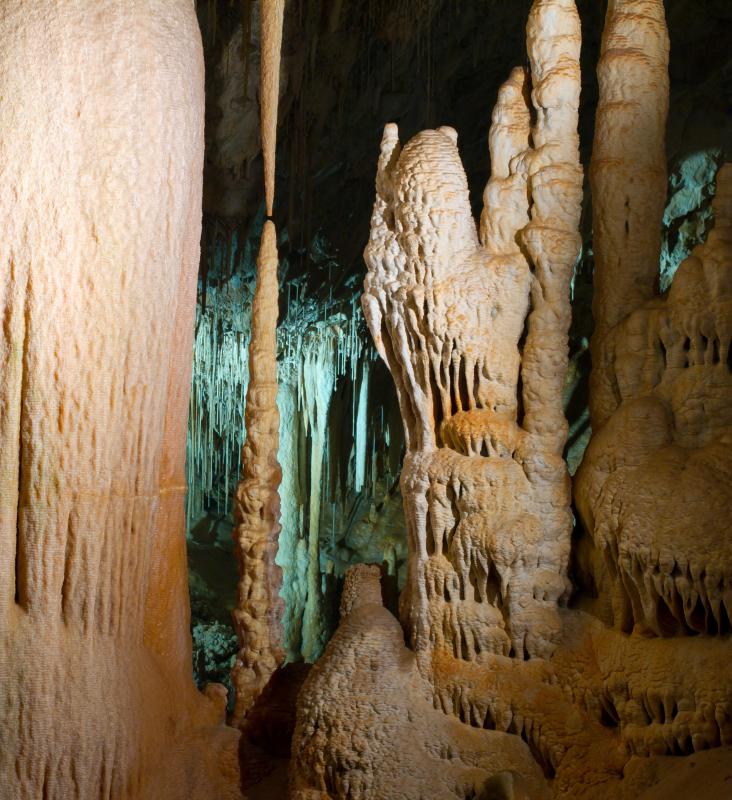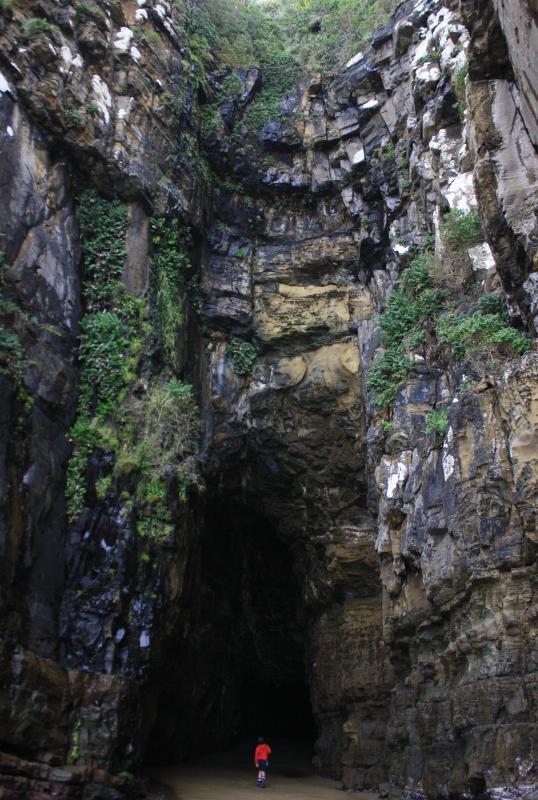At AllThingsNature, we're committed to delivering accurate, trustworthy information. Our expert-authored content is rigorously fact-checked and sourced from credible authorities. Discover how we uphold the highest standards in providing you with reliable knowledge.
What is a Stalagmite?
A stalagmite is a type of rock formation which appears in caves. It is considered a type of speleothem, or cave deposit: you may also be familiar with stalactites, another type of speleothem. Stalagmites grow very slowly over hundreds of years, and they can take on fantastical dimensions and shapes as they develop. Some very fine examples of stalagmites can be seen at Zhi Zen cave in China, Carlsbad Caverns in the United States, Grotta Ispinigoli in Italy, and Cueva San Martin Infierno, in Cuba.
A stalagmite forms when mineralized water drips from the ceiling of a cave to the floor. As the water slowly evaporates away, it leaves behind a small deposit of minerals, and this deposit will slowly build up in a cave where water drips in regular locations. Over time, the deposit will grow into a a roughly conical shape which points upward at the ceiling from the floor. Commonly, stalagmites are made from calcium carbonate, because they appear in limestone caves, although other minerals may appear in a stalagmite as well.

In cross-section, observers can clearly see the layers of deposited material which make up a stalagmite. In some cases, the composition of these layers may change in subtle ways, creating bands of texture and color which are invisible unless the stalagmite is cut open. These formations often occur near stalactites, mineralized formations which are caused by deposits on the ceiling of a cave.

Since the names for these two formations are very similar, some people have difficulty telling them apart. One thing which may help you remember is the shape. Stalactites have very regular elongated shapes, almost like icicles, with pointed ends. Stalagmites, on the other hand, have more irregular shapes, and they tend to be more broad, with flattened to rounded tops. Unlike stalactites, stalagmites are solid, but you have no way of knowing that without cutting the rock formation open, which is not recommended.

When you visit a cavern with speleothems, try not to touch them. These slowly growing rock formations are almost like living organisms, and the oils from your hands can disrupt the deposition of minerals, altering the shape of the resulting rock deposit. It is also a good idea to resist the temptation to remove stalagmites as mementos, since they take hundreds of years to form and by leaving them in place, you will ensure that future generations can enjoy them. Photography is encouraged at caves around the world if you want something to remember your visit by.
Frequently Asked Questions
What exactly is a stalagmite?

A stalagmite is a type of speleothem, or cave formation, that rises from the floor of a limestone cave due to the accumulation of material deposited by dripping water. This mineral deposit primarily consists of calcium carbonate and forms over centuries as water carrying dissolved calcite drips from the cave ceiling and leaves behind a small mineral deposit with each drop.
How does a stalagmite form?
Stalagmites form through a slow and persistent process where water seeping down from the surface or through the cave ceiling dissolves limestone, creating a solution rich in calcium carbonate. When this water reaches the air of the cave and drips onto the floor, carbon dioxide is released, causing the calcium carbonate to precipitate and gradually build up to form a stalagmite.
How long does it take for a stalagmite to grow?
The growth rate of stalagmites is remarkably slow, often less than 10 centimeters every thousand years. According to studies, some of the largest stalagmites may be tens of thousands to hundreds of thousands of years old. The exact rate can vary widely depending on the water supply, drip rate, and the concentration of calcium carbonate in the water.
What is the difference between a stalagmite and a stalactite?
Stalagmites and stalactites are both formed by the deposition of minerals from dripping water in caves, but their locations differ. Stalactites hang from the ceiling of a cave, while stalagmites grow upward from the cave floor. Over time, these formations can grow towards each other and may eventually connect to form a column or pillar.
Can stalagmites tell us anything about Earth's past climate?
Yes, stalagmites can be valuable climate archives. By analyzing the isotopic composition and trace elements within the layers of stalagmites, scientists can infer past rainfall patterns, temperature, and even vegetation types. These data can help reconstruct climate conditions over the period during which the stalagmite was formed, providing insights into Earth's climatic history.
Are stalagmites protected by law?
In many countries, stalagmites are protected under national conservation laws due to their scientific and natural heritage value. Disturbing or damaging these formations is often illegal, and caves with significant speleothems may be designated as protected areas or tourist attractions with regulated access to ensure their preservation for future generations.
AS FEATURED ON:
AS FEATURED ON:














Discussion Comments
One of the most fascinating speleomens (I can't remember if it was a stalagmite or a stalactite) I have ever seen was in the basic form of a heart. It was a large form and they had a red light shining on it. How eery! I looked at it for the longest time. Nature certainly does create some beautiful sights.
Caves themselves are intriguing places to explore, but when they have stalagmites and stalactites growing all around, it seems like a trip back to the time of the ancients. I wonder if our ancient ancestors lived in the caves with stalagmites and stalactites, or if they were superstitious about them and stayed away.
I have been in several caves where there were stalagmites and stalactites growing. They are quite a sight to see. It's amazing to think how many years it has taken them to get to where they are.
The words stalagmite and stalactite are very similar and hard to remember which is which. Somewhere I learned an easy way to remember - stalagmites, which grow from the ground "might" reach the ceiling, and stalactites stay "tight" to the ceiling. I never forget now.
The caves that I explored were quite slippery, so I'm glad they had railings. I hope everyone who visits caves with these formations, is careful not to touch or fool with them in any way. They are a real treasure, and need to be saved intact for future generations.
I have always been fascinated by stalactites and stalagmites. There is something magical about both their appearance and the fact that they even exist. They look to me like the stuff of fairy tales.
I remember learning about them in school. When my teacher first told us about them, I thought I would have a hard time distinguishing between the two, but then she told us a way to keep them straight in our minds. “Stalactite” has a “c” in it, and they grow from the ceiling. “Stalagmite” has a “g,” and it grows from the ground.
I never had a problem remembering which was which after that. I have yet to see any in person, but I hope to one day. It would be awesome to see something hundreds of years in the making.
I have been on a few different cave tours, but one that is most memorable for me is a trip to Ruby Falls in Tennessee.
You have to drive up a long, winding road to get to this cave which is at the top of a mountain. I remember seeing many different cave formations that even included some ice stalagmite. I am glad we had a tour guide who explained what we were seeing as we walked through the cave.
The highlight of the tour is when you are led to the area that is just underneath the falls. You are in complete darkness in this damp cave and when they turn the lights on the falls, it almost takes your breath away.
The waterfall drops over 100 feet into the cave. It is really accented with the special lighting they use to enhance it. Everyone one in our group was just staring at this in awe.
One year when we were coming back from a trip to Florida, we stopped to visit Mammoth Caves in Kentucky.
I have always been fascinated with caves and caverns and was excited to do some exploring here. Because I wanted to learn as much as possible, we took a guided tour through one of the big caves.
This was very informative and they did a good job of showing and explaining the difference between stalactites and stalagmites. It really helped when there were several examples of both to compare.
Another interesting things we did was take a boat tour into the cave. This gave a whole new dimension to the trip.
All of their tours were very well done. They had lighting in the caves and handrails that were helpful. This also made it enjoyable for people of all ages.
Post your comments